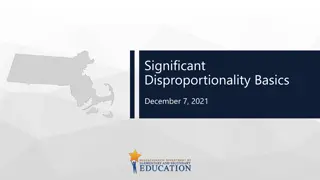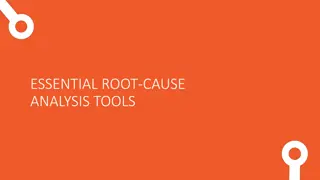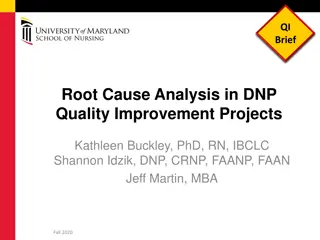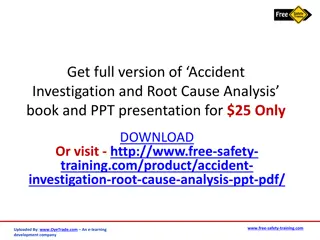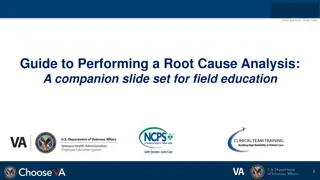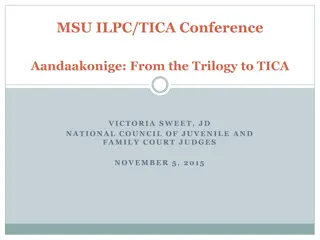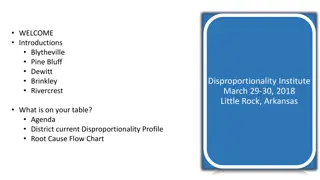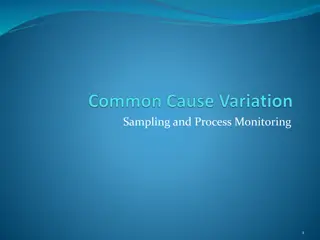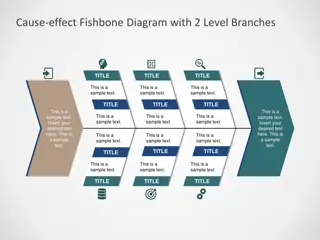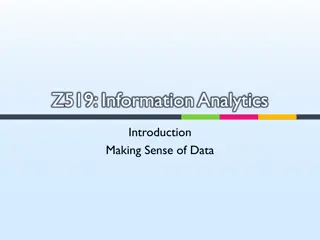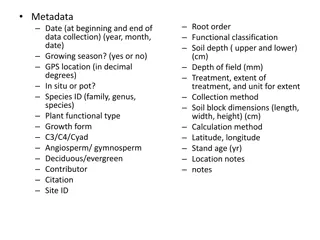Exploring Disproportionality in Education: Root Cause Analysis and Data-Driven Decision Making
Delve into the complexities of educational disproportionality through the lens of root cause analysis and data-driven decision making. Discover ways to address issues of representation and identification in special education, while considering the impact of deep-rooted factors on outcomes and disparities within districts.
Download Presentation

Please find below an Image/Link to download the presentation.
The content on the website is provided AS IS for your information and personal use only. It may not be sold, licensed, or shared on other websites without obtaining consent from the author. Download presentation by click this link. If you encounter any issues during the download, it is possible that the publisher has removed the file from their server.
E N D
Presentation Transcript
WELCOME What is on your table? Agenda for both days Success Gap Rubric Copies Books (1 per district): Data Driven Decision Making (book and workbook) School Leader's Guide to Root Cause Analysis Flash Drive 3 version s of the Success Gap Rubric District s most recent Success Gap Rubric District s most recent self-assessment District s most recent Special Education Discipline Data District s most recent Special Education Child Count Data Introductions How Deep Do Your Roots Go? Disproportionality Institute March 8-9, 2017 Little Rock, Arkansas
How Deep Do Your Roots Go? Disproportionality Institute March 8-9, 2017 Little Rock, Arkansas
The depth of roots depend on the environment similar to your district. Loose soil allows for deeper roots Compact soils create a horizontal root system IS HAVING DEEP ROOTS GOOD OR BAD?
When it comes to the causality of disproportionality would you rather have deep roots or shallow roots? IS HAVING DEEP ROOTS GOOD OR BAD?
Special Education Annual Performance Report Indicators I-4A & 4B: Discipline I-9: Disproportionate Representation in Identification I-10: Disproportionate Representation in a Specific Disability Category HOW DID YOU GET HERE?
Indicator 4A (Difference > 1.36) Indicator 4B (Difference >4) Indicator 10 Rate Hispanic Difference Black Difference Black (ID) White (SLD) Sped Rate GE Rate Rate GE RATE Difference 10.7 9.44 DEWITT SCHOOL DISTRICT DERMOTT SCHOOL DISTRICT RIVERSIDE SCHOOL DISTRICT (CRAIGHEAD) 3.03% 3.64% 1.49% 1.27% 0.27% 0.00% 1.76% 3.37% 1.49% 1.27% CEDARVILLE SCHOOL DISTRICT MARION SCHOOL DISTRICT MCGEHEE SCHOOL DISTRICT CONWAY SCHOOL DISTRICT VILONIA SCHOOL DISTRICT PARAGOULD SCHOOL DISTRICT GLEN ROSE SCHOOL DISTRICT CEDAR RIDGE SCHOOL DISTRICT NEWPORT SCHOOL DISTRICT PINE BLUFF SCHOOL DISTRICT LEE COUNTY SCHOOL DISTRICT ENGLAND SCHOOL DISTRICT BLYTHEVILLE SCHOOL DISTRICT RIVERCREST SCHOOL DISTRICT GOSNELL SCHOOL DISTRICT BRINKLEY SCHOOL DISTRICT CLARENDON SCHOOL DISTRICT MARVELL SCHOOL DISTRICT MENA SCHOOL DISTRICT PULASKI CO. SPEC. SCHOOL DISTRICT FORREST CITY SCHOOL DISTRICT FAYETTEVILLE SCHOOL DISTRICT 2.00% 4.26% 2.05% 0.24% 1.89% 0.43% 1.76% 2.37% 1.63% 6.82 4.93 1.89% 4.32 8 0.09% 7.91% 2.01% 1.47% 2.27% 2.26% 6.40% 3.45% 3.92% 7.27% 3.92% 2.72% 6.74% 2.56% 10.45% 0.56% 0.10% 0.82% 0.66% 4.88% 1.79% 1.98% 3.40% 0.40% 0.38% 2.98% 0.58% 4.99% 1.45% 1.37% 1.45% 1.60% 1.52% 1.66% 1.94% 3.87% 3.52% 2.34% 3.76% 1.98% 5.46% 7.98 7.69 4.59 7.29 3.40% 0.40% 8.47 5.13 10.7 5.50 4.54 5.73 2.98% 0.58% 4.99% 4.02 3.16% 6.20% 1.95% 1.52% 3.79% 0.39% 1.65% 2.40% 1.56% 22 1 7 1 1
Indicator 4A: Suspension/Expulsion Rates of suspension and expulsion: A. Percent of districts that have a significant discrepancy in the rate of suspensions and expulsions of greater than 10 days in a school year for children with IEPs; and Indicators and Current Methodology B. Percent of districts that have: (a) a significant discrepancy, by race or ethnicity, in the rate of suspensions and expulsions of greater than 10 days in a school year for children with IEPs; and (b) policies, procedures or practices that contribute to the significant discrepancy and do not comply with requirements relating to the development and implementation of IEPs, the use of positive behavioral interventions and supports, and procedural safeguards. Significant Difference is identified if the special education rate is 1.36 percentage points higher than the general education rate.
Indicator 4B: Suspension/Expulsion Rates of suspension and expulsion: A. Percent of districts that have a significant discrepancy in the rate of suspensions and expulsions of greater than 10 days in a school year for children with IEPs; and Indicators and Current Methodology B. Percent of districts that have: (a) a significant discrepancy, by race or ethnicity, in the rate of suspensions and expulsions of greater than 10 days in a school year for children with IEPs; and (b) policies, procedures or practices that contribute to the significant discrepancy and do not comply with requirements relating to the development and implementation of IEPs, the use of positive behavioral interventions and supports, and procedural safeguards. Significant Difference is identified if the rate for a racial/ethnicity category within special education when compared to all racial/ethnic groups in general education is greater than 4 percentage points than the general education rate.
Indicator 9: Disproportionate Representation - Identification Percent of districts with disproportionate representation of racial and ethnic groups in special education and related services that is the result of inappropriate identification. (20 U.S.C. 1416(a)(3)(C)) Indicators and Current Methodology A. Districts are identified as having a disproportionate representation if the Risk Ratio is greater than 4 Districts must complete a self-assessment of policies, procedures, and practices. B.
Indicator 10: Disproportionate Representation Disability Category Percent of districts with disproportionate representation of racial and ethnic groups in specific disability categories that is the result of inappropriate identification. (20 U.S.C. 1416(a)(3)(C)) Indicators and Current Methodology A. Districts are identified as having a disproportionate representation in a disability category, if the Risk Ratio is greater than 4 Districts must complete a self-assessment of policies, procedures, and practices. B.
Presenters Nancy O Hara, IDEA Data Center Terry Long, IDEA Data Center Let s Get Started!
Handout Flash Drive Success Gap Rubric in Excel
Presenters Mistila Hunt Allison Prewitt Root Cause Analysis
Discipline in the Student GPS
Who handles discipline data in the schools? Principal Assistant Principal Secretary Is there a set data entry form used across the district? Is the district using the state codes or having to convert from district codes to the state codes for Cycle 7? Has the person filling out the discipline report been trained on the meaning of the various discipline codes? What is out-of-school suspension vs. expulsion? Do they realize an expulsion requires school board approval? Removal from a building to an ALE or homebound is not an expulsion or suspension? A student moved to homebound for discipline is still enrolled in the building that supports their grade level Data Quality and eSchool
Common Errors The Action Taken was coded as an expulsion because the student has been removed from the building to an alternate setting. Students receiving OSS are coded as expulsion The number of days assigned for in-school and out-of- school suspensions are duplicative. One incident 3 infractions Insubordination Fighting Tobacco Action Taken OSS for three days Number of days entered 9 3 per infraction What should have been entered? One day per infraction totaling 3 days Data Quality and eSchool
Remember the PLAN should focus on the area which you were identified Success Gap Rubric in Excel CEIS Plan Linking funds Developing a Plan
CEIS Plan Research based: What is the research base for the plan? Program Description: How does the plan address at-risk students in the district, particularly those groups that were significantly over-represented in the special education population? How many students are being served? What amount of time do these students spend in the program daily/weekly? What are the materials used? If funds are being used for purposes other than direct student services, please provide an explanation. Current CEIS Plan Program Evaluation: What tool is being used to measure progress? Plan Development: What changes (if applicable) are needed to plan/program based on data results?
Addressing root causes Team Planning Time Making specific plans Tied to the area of identification
Team Report Out
Disproportionality in the Annual Performance Report New Regulations: Coordinated Early Intervening Services Indicator 4A: OSS/Expulsion > 10 days SE vs GE. Allowable Difference 1.36 percentage points Indicator 4B: OSS/Expulsion > 10 days by race. Specific Race in SE compared to ALL races in GE. Allowable Difference 4 percentage points Disproportionality: Annual Performance Report vs CEIS New Regulations Discipline: OSS > 10 days by race OSS 10 days by race ISS > 10 days by race ISS 10 days by race Total removals by race Indicator 9: Identification - Student with a Disability. Allowable Difference RR <4.01 Identification: Student with a Disability Indicator 10: Identification: Disability Category. Allowable Difference RR <4.01 Identification: Disability Category Not Applicable Least Restrictive Environment: < 40 of the day in the regular classroom and separate School
Disproportionality Disproportionality exists when students in a racial or ethnic group are more likely to be identified as a student with a disability identified as a student with a particular disability placed in more restrictive settings suspended or expelled than students in other racial or ethnic groups New Disproportionality Regulations
Summary of new regulations (1) establish a standard methodology States must use (2) clarify that States must address significant disproportionality in disciplinary actions New (3) clarify requirements for the review and revision of policies, practices, and procedures when significant disproportionality is found; and Disproportionality Regulations (4) require that LEAs identify and address the factors contributing to significant disproportionality as part of comprehensive coordinated early intervening services (comprehensive CEIS) and allow these services for children from age 3 through grade 12, with and without disabilities.
Area Current New Identification All disabilities and six disability categories; ages 6-21 Same categories (ages 3-5 included by July 2020) Placements Inside Regular Class 40-79% Inside Regular Class < 40% Separate Placements Inside Regular Class <40% Separate Placements Current CEIS Methodology Compared to New Disproportionality Regulations Discipline OSS > 10 days, consecutively or cumulatively OSS > 10 days OSS 10 days ISS > 10 days ISS 10 days Total removals Calculation Risk Ratio > 4 for identification and placements, > Significant Difference >4 for discipline Risk ratio and alternate risk ratio N-sizes 95% to 5% racial/ethnic group; 40 for numerator for identification, disability, and placements; More than 1 student in discipline 10 for numerator, 30 for denominator of risk calculations Years 3 consecutive years Up to three consecutive years Progress Not evaluated Can evaluate
98 Ways Seven racial/ethnic groups Fourteen areas All disabilities Six disability categories (ID, ED, SLD, AU, OHI, SI) Two placement categories Five discipline groups New Disproportionality Regulations A district has ninety-eight opportunities to be identified as being significantly disproportionate
14 Risk Thresholds All disabilities by race Six disability categories by race ID, ED, SLD, AU, OHI, SI Two placement categories <40 % of the day in the regular classroom Separate School (Day Treatment/School) Five discipline groups >10 days OSS >10 Days ISS <11 days OSS <11 days ISS Total Removals (ISS/OSS/ALE) New Disproportionality Regulations
Next Steps and TimeLine oOne month to finish rubric and plans in Excel. oEmail the completed Rubric in Excel to jafields@ualr.edu by April 8, 2017. oLetters notifying the districts of their disproportionate identification and the required review of policies, procedures, and practices will be sent by the end of March. What is Next?








